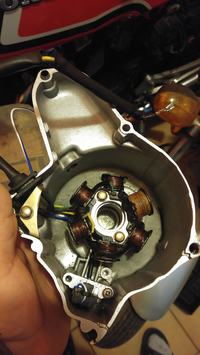Hello.
I have a problem with Barton spark with FMB 139 engine.
After replacing the head, the spark disappeared. Checking everything in turn, I came to the conclusion that the voltage from the pulser did not come out. So I replaced the stator with the pulser. The spark appeared. The engine was going to be hard to start, when it grabbed it worked very unevenly. I switched it off and once again did not fire, again there is no spark. So I bought another stator with a pulser and the spark is still gone. And the power supply from the pulse generator is max 0.40v Is it probably too little? I also observed that when I touch another cable with good voltage to the pulse generator cable, the spark appears at this point. What can this be a fault? I have no strength and do not want to unnecessarily exchange a half motor. Help!
I have a problem with Barton spark with FMB 139 engine.
After replacing the head, the spark disappeared. Checking everything in turn, I came to the conclusion that the voltage from the pulser did not come out. So I replaced the stator with the pulser. The spark appeared. The engine was going to be hard to start, when it grabbed it worked very unevenly. I switched it off and once again did not fire, again there is no spark. So I bought another stator with a pulser and the spark is still gone. And the power supply from the pulse generator is max 0.40v Is it probably too little? I also observed that when I touch another cable with good voltage to the pulse generator cable, the spark appears at this point. What can this be a fault? I have no strength and do not want to unnecessarily exchange a half motor. Help!




